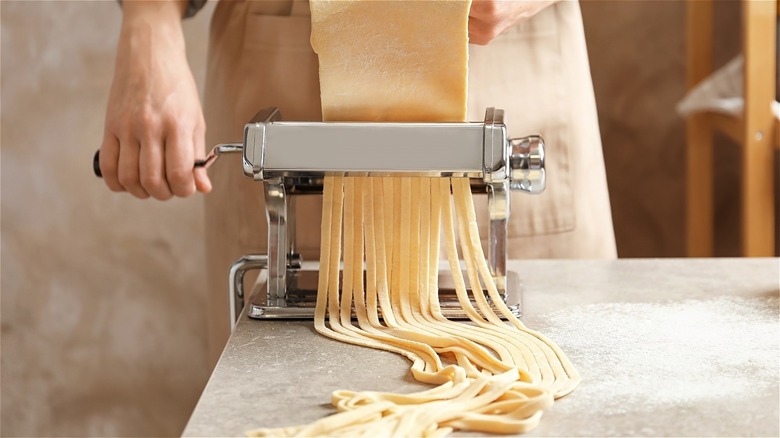The Hack That Will Help You Make Fondant With A Pasta Maker
If you've ever admired a cake created by a talented baker that looks almost too good to be true — or a cake designed to fool you into thinking it's something else, a specialty of the Netflix reality show "Is It Cake?" — chances are you've seen just what fondant can do. While some bakers prefer to work exclusively with buttercream in order to coat their cakes, others love the flexibility fondant has. As The Spruce Eats notes, fondant can be used to create an incredibly smooth surface, it can be molded into various shapes, and it can be texturized in a wide variety of ways.
Yet, while you can continually smooth out your buttercream and make small adjustments until you're happy with it, fondant can be a bit trickier to handle. As More Than Baking explains, it has a tendency to dry rather quickly and, while it can be rehydrated slightly and brought back to its original malleable state, you can't roll it out endlessly without it cracking and suffering.
And that's one of the most challenging parts of coating an entire cake in fondant — you need to roll out a layer of the mixture that's large enough to cover your baked goods, and you need to do so relatively quickly in order to ensure it doesn't dry out. If you've always been rolling fondant out with a rolling pin, or simply have been too intimidated to even try, there's a tool you'll want to test out — a pasta maker.
Creating seamless sheets of fondant
As Taste of Home explains, that pasta maker you occasionally take out to whip up homemade pasta actually serves as a fantastic tool for creating thin fondant sheets in no time flat. Unlike rolling fondant out by hand, the pasta maker has a built-in mechanism to ensure you achieve uniform thinness. As an added bonus, since the process is much quicker, there's a bit more time to handle your fondant and mold it into the shapes you need it to be or drape it across your pastry before it starts to dry out.
There are a few things to keep in mind in order to ensure the best results, though. As a user in the Cake Central forums wrote, you need to ensure your fondant is completely lump-free before putting it through the pasta maker, or you'll see those issues in the finished fondant. Another suggested that patience is the name of the game — it is a quicker process than hand rolling it, but you might still want to push the fondant through a few times until you achieve your desired thinness rather than trying to transform it from a lump of fondant into a delicate, thin sheet in one go.
And, in order to counteract the potential stickiness, since fondant isn't packed with flour the way pasta dough is, you may want to dust it with something, as Coloured Sugar advises. Some prefer icing sugar, while others swear by cornstarch.

